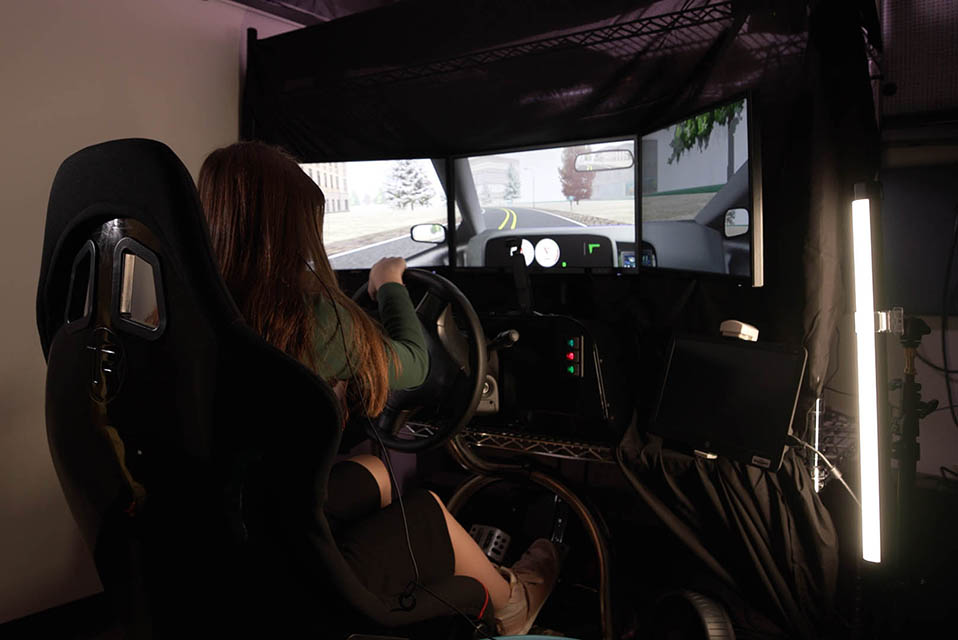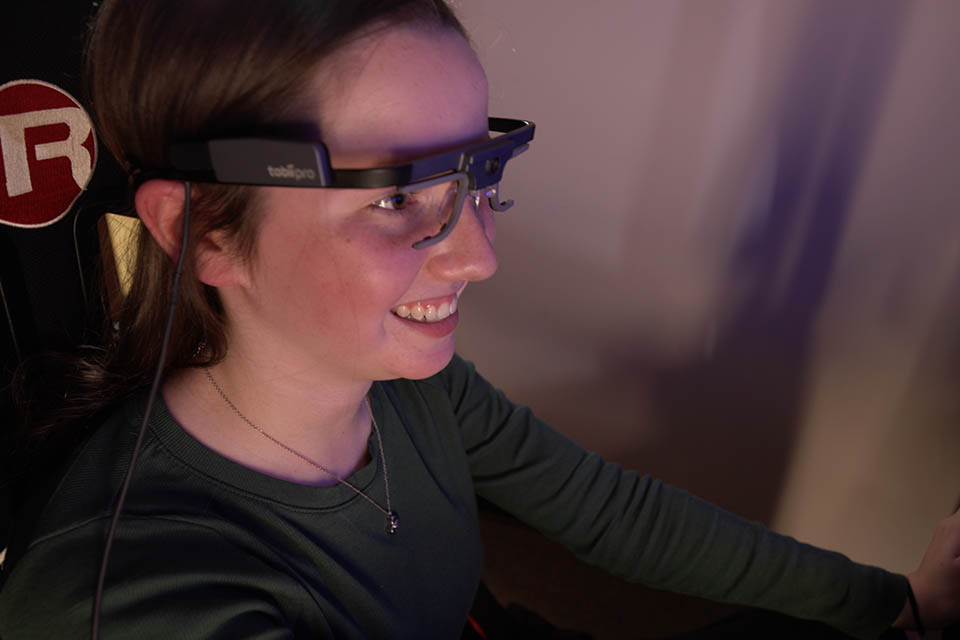On the Road with ADHD
Step into the driver’s seat alongside one Saint Louis University researcher who addresses the limitations placed on adolescent drivers with ADHD and opportunities for improved driving programs.Driving requires multiple facets of our attention. From blaring horns to other vehicles careening past us, there is plenty for our senses to take in. As we drive, we periodically glance away from the road to complete simple tasks such as adjusting our mirrors, putting on sunglasses, or talking with passengers in the backseat. Experienced drivers may not give a quick glance away from the road much thought because it has simply become routine.
Annie Artiga Garner, Ph.D., associate professor of psychology at SLU and clinical psychologist, understands even the smallest glance away could lead to a dangerous crash — especially for a new adolescent driver. But for those with attention-deficit/hyperactivity disorder (ADHD), the rules of the road may be even more difficult to process while in the driver’s seat.
The Need for ADHD Research
Garner is a long-time researcher of ADHD and its impact on individuals across their lifespans. Early in her career, she recognized a distinct gap in research among teens with an ADHD diagnosis. Teens with ADHD are at an increased risk for car crashes. However, she said a majority of existing studies documenting ADHD-related driving problems have lumped young drivers with more experienced drivers, which limits our understanding of the combined impact of being young and having ADHD.
“From childhood to adulthood, one area that has received less attention is driving, and driving is an area that has potentially deadly consequences,” Garner said. “It’s an overlooked area with public health implications.”
As one of the most common neurodevelopmental disorders among children, ADHD affects a person’s level of attention, hyperactivity and impulsivity. Driving requires individuals to make quick decisions based on controllable factors, such as road signage, and uncontrollable factors, such as the driving tendencies of others.
“When we drive, we need to look away from the road to check our speedometer or look over our shoulder to merge into another lane,” Garner said. “Through our research, we found that when teens with ADHD looked away from the road, they looked away for extended periods of time."
With previous research in hand, Garner and her team explored an additional research opportunity to help reduce extended eye glances while driving. This idea set in motion a study that would seek to improve driving among teens with ADHD by teaching them strategies and helping them keep their eyes on the road.
Taking a Digital Approach
In December 2022, Garner co-published an article in The New England Journal of Medicine about their study, “Trial of Training to Reduce Driver Inattention in Teens with ADHD.” She worked as the co-investigator, alongside collaborators at the Cincinnati Children’s Hospital Medical Center, University of North Carolina at Chapel Hill, and University of Massachusetts at Amherst.

The study analyzed two groups of teens with ADHD, aged 16 to 19, as they underwent five sessions within a training program to assess their eye glances while driving. After the sessions, participants were followed for one year through an in-vehicle recording system to assess their real-world driving skills.
The intervention program used the FOcused Concentration and Attention Learning (FOCAL) program to monitor eye glances. It is a single-session desktop software program that trains teens with ADHD to limit the amount of time someone glances away from the road. Garner’s research took this program one step further to create FOCAL+, an enhanced version that includes multiple computerized sessions, eye-tracking monitors, and immediate auditory feedback as they drove in a driving simulator.
“One of our main goals was adapting the interventions in a way that would work for teens with ADHD,” she said. “We feel like we were able to accomplish something significant.”

The computerized program showed teens a split screen, displaying both a driver’s perspective of the road and a map. As teens pressed or depressed the space bar, they would simulate multitasking while driving. If a map was present on the screen for more than three seconds, an alarm sounded.
After completing the computer program, the group engaged in driving simulation training, using a console with a steering wheel and pedals. Participants wore special eye-tracking glasses while they identified symbols on their dashboards. If they looked away for more than two seconds, an alarm sounded — notifying the teen of an extended eye glance.
Garner explained teens with ADHD learn to better estimate the length of their glances when they receive real-time feedback. The introduction of feedback within the study invited teens to form new habits by immediately recognizing their eye glances while driving and developing more confidence in their skills over time.
“Driving is significantly related to independence, job opportunities and life success in the U.S.,” Garner said. “If individuals with ADHD aren’t learning how to drive safely because they are concerned they may not be good at it or they’ve had lots of crashes before, then we have a situation where individuals' lives are limited in terms of their potential, access to jobs, and overall life success. This intervention has the potential to change that trajectory for people.”

Evaluating Real-World Driving
New habits can be formed in the controls of a simulated environment, but it's in the real world where driving skills are put to the test. A recording system was installed to assess a participant's vehicle’s forward or lateral accelerations to examine the impact of the intervention on real-world driving. The accelerations were tracked as g-force events during the real-world driving period — allowing Garner and her team to evaluate if those events were due to prolonged eye glances.
“The camera would go off every time their car had an abrupt change in g-force,” she said. “If they had a hard stop or an event like it, we would code what was happening inside the car because it retroactively saved what was going on some seconds before.”
Garner and the team created a coding scheme for each of the 6,000 videos collected, and trained her team to assess each collected g-force trigger. Codes included details such as what happened before the event, what was going on in the environment at the time, whether or not the teen had a crash or near crash, and if the driver engaged in extended eye glances or other distractions.
Throughout the year, the FOCAL+ group had 24% fewer long glances than the control group. Additionally, crash and near crash rates in the FOCAL+ group was 3.4%, compared to 5.6% for the control group — reducing 40% of crashes and near crashes among the FOCAL+ group.
“We think these findings really make a difference for not just the teens themselves but also everyone else who is on the road with them,” she said.
Success Inspires Opportunities
As a result of the study’s success, the program is currently available through Cincinnati Children’s Hospital as a clinical service for all teens, including teens with ADHD and anyone else who may want to participate. Additionally, Garner is working on implementing new studies that will broaden the initial research and hopefully expand the driving program to more cities, including St. Louis.
“I’ve been talking with my collaborators in Cincinnati about — once the clinical service is up and running — doing research on how the clinical service is working,” she said. “I’ve also been in conversations with the traffic safety office in Missouri to share my ideas about future projects here in Saint Louis.”

Her ideas prompted additional research around ADHD and driving in her lab at Saint Louis University. As the principal investigator, Garner and her team of researchers at the lab explore the impact of ADHD on daily life with a specific interest on adolescent drivers. Current research has stemmed into emerging topics such as trends in delayed licensure, the impact of sluggish cognitive tempo, and family factors that predict safe or risky driving in this teen population.
One of her greatest opportunities for the future includes expanding the ways teens with ADHD can get this type of training without needing a driving simulator.
“Our next project is looking at developing a virtual reality version of this intervention that could be used more widely in the community,” she said. “It could be used at driving schools, or outpatient through occupational therapy where it might be more accessible to people.”
Expanding Research Endeavors
Throughout each phase of Garner’s education and research, one goal remains at the forefront: creating more opportunities for those who feel limited by an ADHD diagnosis. Garner believes the research she and her colleagues completed reaches beyond those affected by ADHD — impacting the lives of all those who get behind the wheel.
“The work I am doing has a long-term goal of supporting individuals whose diversity has often been looked at as a deficit and a problem,” she said. “Instead, I hope to provide opportunities to help individuals with ADHD live full and meaningful lives.”
As more research opportunities emerge, Garner has aspirations to expand her research topics to include more facets of neurodiversity. She hopes her existing and future projects will support those with neurodiverse conditions and help them develop strategies for daily activities like driving.
Garner is actively exploring research centered on neurodiversity-affirming practices and therapist education. Through her ongoing dedication to ADHD and neurodiversity, her work continues to shine a light on an underrepresented area of research, allowing others to navigate the roads of life with confidence — no matter their condition.
“When I think of humankind, I think about the diversity that comes with humanity, how beautiful diversity is, and how important it is for humanity to reach its full potential,” Garner said. “If we can embrace and celebrate each other’s diversity, then I think it benefits us all.”
Story by Mary Pogue, senior copywriter, Paradigm.
This piece was written for the 2023 SLU Research Institute Annual Impact Report. The Impact Report is printed each spring to celebrate the successes of our researchers from the previous year and share the story of SLU's rise as a preeminent research university. Design, photography, and some writing contributions are made by Paradigm. More information on the Impact Report can be found here.

















